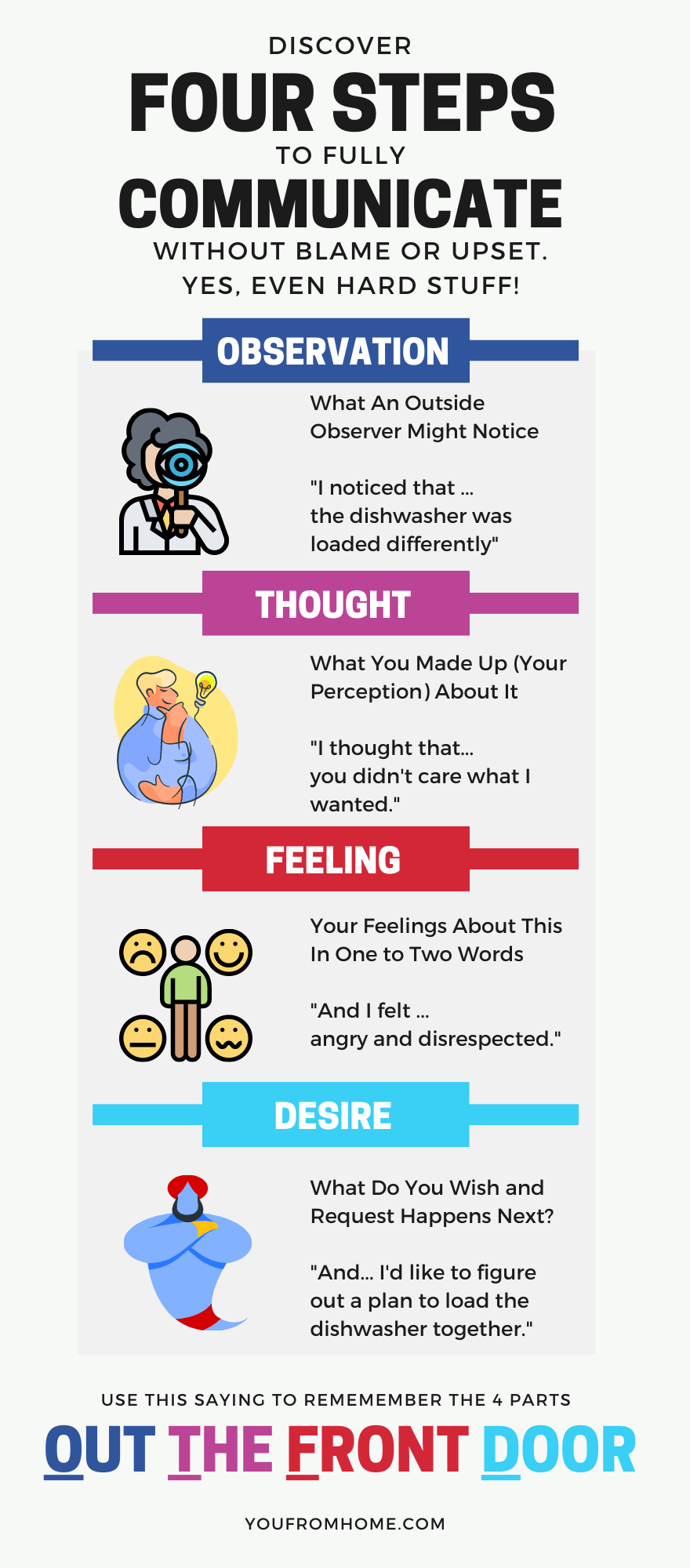Something big happened.
You are upset.
You blurt something out that only partially communicates what’s going on.
It triggers the other person.
They blurt something back.
Blurts fly like crazy.
Before you know it, you are in a fight – about who knows what (blurts?).
Nobody wins this. Not even the blurts.
So, are you ready to break that cycle, and still be true to yourself?
Fully Communicating
For most of us, when we are upset, we do not fully communicate. This makes it difficult for another person to meet or even hear our request. In fact, very rarely do we even make a request in this upset blurting state. And it makes it nearly impossible for us to get what we want.
To help bring this home, let’s go with a hypothetical situation.
Let’s say that you open the dishwasher in the morning, and notice that it’s loaded in a strange way. It may have dishes with food on them that you know won’t get clean. It may also be loaded in a way that less things can get washed. You’ve told your partner or child (or both) several times how you want it loaded, and it’s not happening. To make matters worse, you are tired and have not had your coffee yet.
While your dishwasher etiquette may be pristine at your house, you probably have something close to this situation to relate to, right?
So, what does a better communication look like for this?
A full communication has a structure to it that encompasses four major things:
- Observation – What would an outside party also notice about this? In our dishwasher example, this would be something like “Hey, I noticed the dishwasher was loaded differently than I requested.”
- Thought – What meaning about this did you make up about the situation (no, not the Jersey Shore character)? “And I thought that you didn’t care what I wanted.”
- Feeling – What are one or two words you can use to describe your feelings about this? Remember feeling words are things like mad, glad, sad, upset. Shorter is better here. “And I felt angry and disrespected.”
- Desire – What would you like to happen or the next steps to be? You can also think of this as a request. “And I’d like to figure out a plan to load the dishwasher, so everything gets clean. Can we find a time to do that please?”
Now that you know the four steps, imagine receiving a communication like this.
Would you feel as on guard or defensive as someone asking instead “Why didn’t you load the dishwasher right? You don’t care about anything. I’m so sick of this.” Or even worse, holding up a dirty dish, getting a glaring look and them asking something like “Really?” and then walking away.
Neither of those examples are likely to give you the results you seek – and there’s a high likelihood of blurts. Instead, this four-part structured communication is about you showing up fully, and giving the other person a chance. It’s not to manipulate them to doing what you want. Your desire is a request, and the problem-solving happens between each of you.
It’s blurt free.
For you teachers and parents, this can be a very powerful tool to teach your students and children. They will be more able to explain what’s going on in their worlds to you and others. You will also have more insight into what is truly going on for them.
To help you do this, you can use the attached infographic and remember “Out The Front Door” (for Observation, Thought, Feeling and Desire). You can also use four fingers with O, T, F, D.
Ready to put this into action?
Think of the last argument or upset you had with someone, and try to remember what started it. It could also just be an internal discussion you had, being upset about something. Yes, get past the blurts.
Now, use the four steps and imagine communicating them to another person. You can write it out or talk to yourself or even look in the mirror and practice. You may notice that you need to take a few deep breaths before this. Oxygen is your friend and can be a great help here.
By rehearsing this, you are giving instructions to your brain about a new pattern it can try out next time. This simple action is doing more than you may realize right now. If you want to take it further, imagine the other person using this to express their concerns back to you.
Next Steps
Now, the next time something hard comes up, you have a structured way to fully communicate with someone else. The outcome will be a lot better than just blurting out a partial communication, and it greatly helps others to truly be in relationship with you. I noticed you read this to the end (observation), and I made up that you liked it (thought). I’m happy and excited (feeling) if it was useful to you and my hope is that you can use it right away with your family and friends – and maybe even at work (desire).









